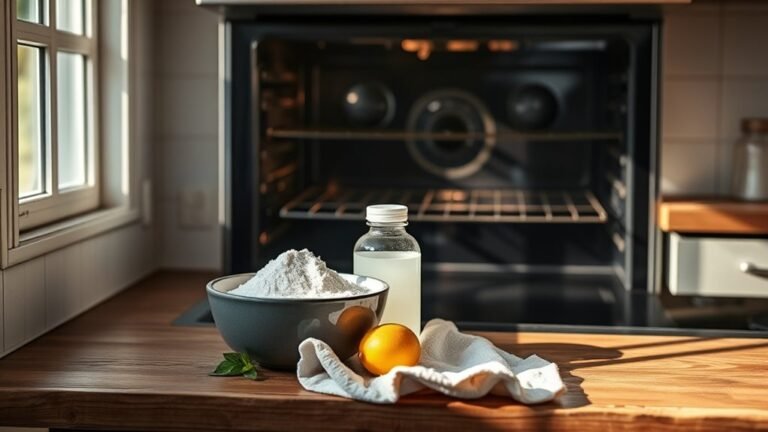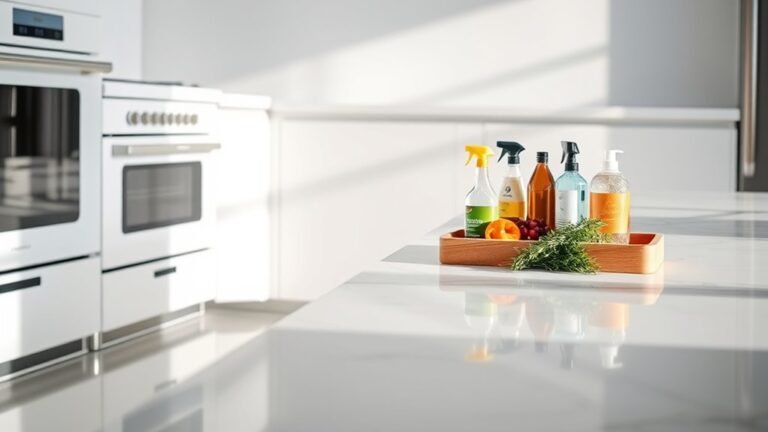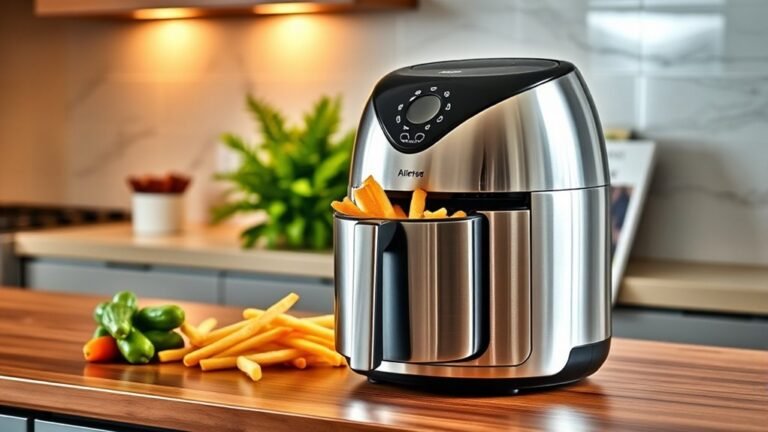How to Make Homemade Coffee Machine Cleaner
To make a homemade coffee machine cleaner, mix equal parts white distilled vinegar and water—usually one cup each is ideal. Run this solution through a brewing cycle to break down residue and mineral buildup, then flush with several cycles of plain water to rinse thoroughly. Alternatively, dissolve baking soda in warm water to target coffee oils or use diluted lemon juice for descaling. These natural agents maintain machine performance without harsh chemicals. For detailed preparation and safety tips, additional insights follow.
Why Regular Cleaning of Your Coffee Machine Matters
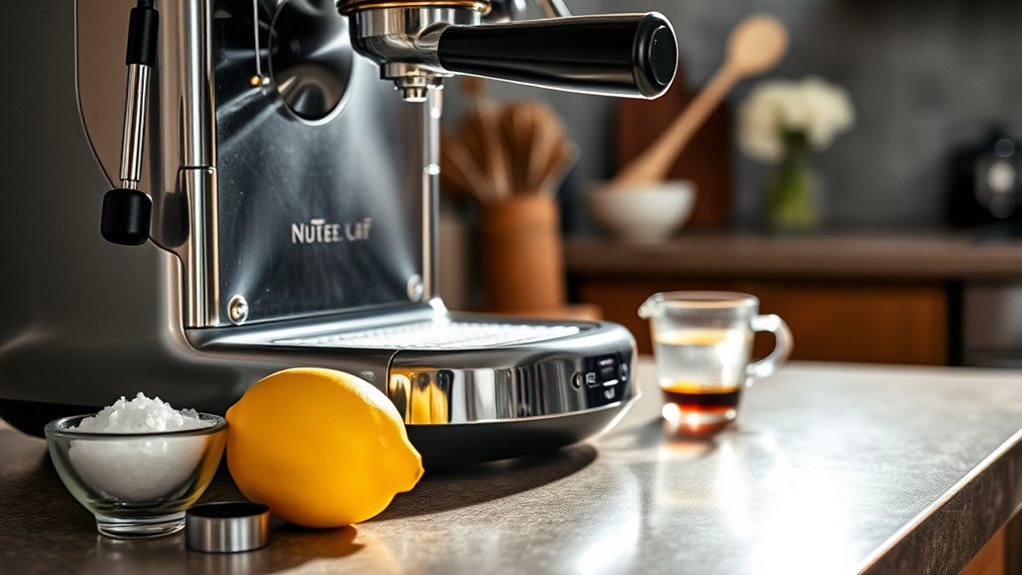
Although it might seem tedious, regular cleaning of your coffee machine is essential to maintain peak performance and guarantee the quality of your brew. Residue buildup from oils, minerals, and coffee particles compromises coffee quality by altering flavor extraction and aroma. You need to eliminate these contaminants to preserve the machine’s internal components and prevent clogging, which directly impacts machine longevity. Neglecting cleaning accelerates wear on seals and filters, leading to costly repairs or premature replacement. By implementing a consistent cleaning routine, you facilitate ideal water flow and temperature control, which are critical for consistent extraction. Ultimately, this disciplined maintenance gives you the freedom to enjoy pure, high-quality coffee with minimal interruptions and extends your machine’s operational lifespan efficiently.
Common Ingredients for Homemade Coffee Machine Cleaners
You’ll find that natural cleaning agents like vinegar and baking soda are effective for breaking down coffee residue without damaging your machine. These safe household ingredients offer non-toxic, biodegradable options that maintain your equipment’s integrity. Understanding their chemical properties helps you optimize cleaning efficiency while minimizing wear.
Natural Cleaning Agents
Because coffee machines accumulate mineral deposits and coffee oils over time, selecting effective natural cleaning agents is essential for maintaining peak performance. You want natural ingredients that efficiently break down residues without harsh chemicals. Eco friendly solutions like citric acid, derived from citrus fruits, offer strong descaling power by chelating calcium and magnesium deposits. Baking soda provides mild abrasiveness and neutralizes odors, enhancing cleanliness without damaging components. Additionally, white vinegar’s acetic acid dissolves limescale effectively, though its strong odor requires thorough rinsing. These agents allow you freedom from synthetic chemicals while ensuring thorough maintenance. When choosing natural cleaning agents, prioritize their compatibility with machine materials and environmental impact, ensuring your homemade cleaner is both effective and sustainable. This precision supports optimal machine function and your commitment to eco friendly solutions.
Safe Household Ingredients
When selecting safe household ingredients for homemade coffee machine cleaners, it’s crucial to focus on substances that effectively remove residues without compromising machine integrity. Common eco friendly options include distilled white vinegar, known for its acidic properties that dissolve mineral buildup, and baking soda, which acts as a mild abrasive and deodorizer. Both ingredients provide cost effective solutions, readily available in most households and safe for internal components when used correctly. Additionally, lemon juice offers a natural acidic alternative, though its citric content may require careful dilution to avoid corrosion. By choosing these ingredients, you maintain your machine’s longevity while adhering to environmentally responsible practices. Always verify proper rinsing after cleaning to eliminate residual acids, preserving both flavor quality and mechanical function. This approach grants you freedom from harsh chemicals and unnecessary expenses.
How to Prepare a Vinegar-Based Coffee Machine Cleaner
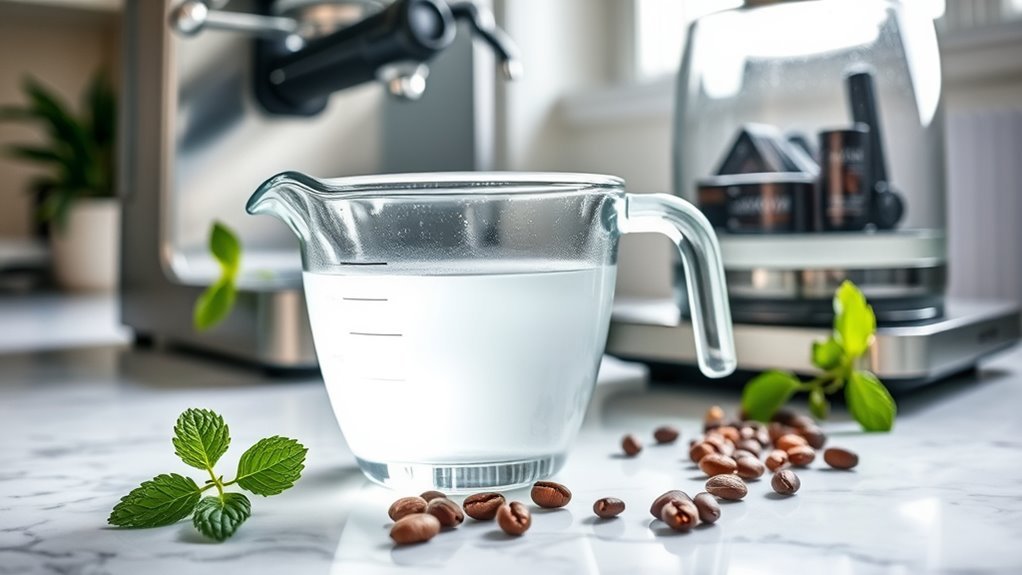
Although commercial coffee machine cleaners are effective, preparing a vinegar-based solution offers a cost-efficient and environmentally friendly alternative. To make this cleaner, mix equal parts of white distilled vinegar and water—typically, one cup of each suffices for a standard machine. Vinegar benefits include its acidic nature, which effectively dissolves mineral deposits and coffee oils without harsh chemicals. For ideal machine performance and longevity, adhere to a cleaning frequency of once every one to three months, depending on water hardness and usage. Before use, verify the solution is well mixed, then run it through a brewing cycle without coffee grounds. Follow with two or three cycles of plain water to flush out residual vinegar taste. This method balances thorough cleaning with user autonomy and sustainability.
Using Baking Soda to Remove Coffee Residue
Vinegar effectively tackles mineral buildup, but coffee residue often requires a different approach. Baking soda is an ideal agent for this task due to its mild abrasiveness and alkaline nature, which neutralizes acidic oils and trapped residues. When you prepare a baking soda solution, dissolve two tablespoons in a cup of warm water, ensuring complete dissolution for maximum penetration. Apply this solution to the machine’s internal components susceptible to coffee residue accumulation, such as the brew basket and carafe. Let it sit for 15 minutes to break down residues chemically and physically. Following this, rinse thoroughly with clean water to eliminate any residual baking soda, preventing taste interference. This method grants you precise control over residue removal, preserving your machine’s function and your freedom from harsh chemicals.
Crafting a Lemon Juice Solution for Descaling

You’ll find lemon juice effective for descaling because its citric acid dissolves mineral deposits without damaging your coffee machine’s components. To prepare the solution, mix equal parts lemon juice and water for ideal acidity and safety. This precise ratio guarantees efficient cleaning while preventing corrosion or residue buildup.
Benefits of Lemon Juice
Since lemon juice contains natural citric acid, it effectively breaks down mineral deposits and scale buildup within coffee machines. This natural acidity makes lemon juice a powerful yet eco-friendly descaling agent, offering several advantages over synthetic chemicals. When you use lemon juice, you benefit from:
- Lemon benefits: It’s biodegradable and non-toxic, ensuring safe handling and disposal without harming the environment.
- Effective mineral breakdown: Citric acid chelates calcium and magnesium ions, dissolving hard water deposits efficiently.
- Residue-free cleaning: Lemon juice leaves no harmful residues, preserving your machine’s internal components and maintaining coffee flavor integrity.
How to Prepare Solution
Anyone looking to descale their coffee machine effectively should start by preparing a lemon juice solution with the correct concentration of citric acid. Precision in solution ratios guarantees ideal descaling without damaging components. Use fresh lemon juice for consistent acidity. Employ thorough mixing techniques to achieve a homogenous solution.
| Lemon Juice (ml) | Water (ml) |
|---|---|
| 50 | 150 |
| 75 | 225 |
| 100 | 300 |
| 125 | 375 |
| 150 | 450 |
Start with a 1:3 ratio (lemon juice to water) and adjust based on machine sensitivity. Stir the mixture vigorously for 30 seconds to guarantee uniform distribution of citric acid. This method assures an effective, natural descaling agent that suits your freedom-driven maintenance routine.
Step-by-Step Guide to Cleaning Your Coffee Maker
Cleaning your coffee maker involves a series of precise steps designed to remove mineral deposits, oils, and residues that impair performance and flavor. To optimize your coffee brewing experience and integrate this into your maintenance routine, follow these critical steps:
- Fill the water reservoir with your homemade cleaning solution, ensuring it’s adequately diluted to avoid damaging internal components.
- Run a full brew cycle without coffee grounds to allow the solution to thoroughly cleanse the system.
- After the cycle completes, rinse by running two or three cycles with clean water to eliminate any remaining cleaner residues.
Tips for Maintaining a Clean Coffee Machine Between Deep Cleans
Although deep cleans are essential, maintaining your coffee machine between these sessions guarantees consistent performance and flavor. Regularly removing used coffee grounds prevents mold growth and clogging. Immediately discard grounds after each brew to avoid residue buildup. Focus on filter maintenance by rinsing or replacing filters per manufacturer guidelines; this reduces sediment accumulation that impairs extraction efficiency. Wipe down external surfaces and the brew basket with a damp cloth to eliminate oils that degrade taste quality. Flush the system weekly with plain water to clear residual coffee oils and particles. By integrating these precise maintenance habits, you preserve machine functionality and optimize flavor extraction, granting you the freedom to enjoy superior coffee without frequent intensive cleaning interruptions.
Safety Precautions When Using Homemade Cleaning Solutions
When handling homemade cleaning solutions, you should prioritize safety to prevent damage to your coffee machine and avoid personal injury. Wearing appropriate safety gear such as gloves and eye protection minimizes exposure to irritants. Proper ingredient storage is essential; keep cleaning agents sealed and labeled in a cool, dry place away from children and pets. Additionally, guarantee the workspace is well-ventilated to avoid inhaling fumes. Follow these precautions:
- Use safety gear consistently to prevent skin and eye irritation.
- Store ingredients separately to avoid chemical reactions or contamination.
- Rinse the machine thoroughly after cleaning to remove residue that may harm internal components or affect coffee flavor.
Frequently Asked Questions
Can Homemade Cleaners Damage My Coffee Machine’S Warranty?
You should carefully review your coffee machine’s warranty policies before using homemade cleaners. Many warranties specify approved cleaner ingredients, and using unapproved substances can void coverage. While homemade solutions offer freedom, they might contain components that damage internal parts or leave residues, leading to malfunctions. To protect your warranty, compare your cleaner’s ingredients against the manufacturer’s guidelines, ensuring you don’t compromise your machine’s longevity or your rights to service support.
How Often Should I Deep Clean My Coffee Machine Annually?
When it comes to annual cleaning, you should deep clean your coffee machine at least twice a year to maintain peak performance and prevent buildup. Deep cleaning removes mineral deposits and coffee oils that can impair functionality and flavor. If you use your machine daily, consider quarterly deep cleaning. Staying ahead of the curve guarantees your machine runs smoothly, granting you the freedom to enjoy consistently great coffee without unexpected breakdowns or performance drops.
Are Homemade Cleaners Safe for All Coffee Machine Types?
You’ll find homemade cleaner effectiveness varies depending on your coffee machine’s materials and design. While many homemade solutions work well for basic models, they might not be compatible with machines having delicate components or specialized coatings. It’s essential to verify machine compatibility before use to avoid damage. Testing small amounts first and consulting your machine’s manual guarantees best cleaning without compromising functionality, giving you freedom to maintain your coffee maker safely and effectively.
Can I Use Essential Oils to Freshen My Coffee Machine?
Did you know that 85% of coffee lovers cite aroma as key to their brewing experience? You can use essential oils to freshen your coffee machine, but be cautious. Essential oils, rich in volatile compounds, can enhance the coffee aroma if properly diluted and applied externally. However, avoid introducing oils directly into the water reservoir or heating elements, as residues may affect taste and machine function. Precision guarantees aromatic freedom without compromise.
How Do I Remove Mold From My Coffee Machine?
To remove mold from your coffee machine, start by disassembling removable parts and soaking them in a vinegar-water solution for 30 minutes. Scrub thoroughly with a brush to eliminate mold residues. Rinse all components well before reassembling. To ascertain mold prevention, maintain a regular cleaning frequency—ideally weekly—and always empty leftover water after use. This disciplined approach guarantees your machine stays hygienic and your coffee taste remains uncompromised.

